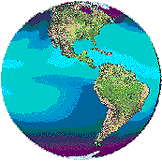|

Week
8: Living Things
Weeks 7, 8, and 9 make up a three-week cycle about living things. Currently,
you are in Week B: Teacher As Scholar.
This week you should
refer to the resources listed under Readings & References, and you
need to complete the assignments listed under Assignments & Rubrics.
This week’s assignments focus on…
Individual:
- Posting
questions about living things, then finding articles and web resources
to build knowledge and background.
- Helping
teammates to answer their questions.
Team:
- Answering
the essential questions about living things with your teammates.
|
Readings
& References
 Read:
The biosphere consists of the earth's living organisms such
as the jungles of the world; grasslands and forests in North America;
fish, kelp, and whales in the ocean; birds in the air; animals on the
farms; bacteria; people; and all of the organic matter not yet decomposed. Read:
The biosphere consists of the earth's living organisms such
as the jungles of the world; grasslands and forests in North America;
fish, kelp, and whales in the ocean; birds in the air; animals on the
farms; bacteria; people; and all of the organic matter not yet decomposed.
A view from space
allows people to see only the really big items: the jungles, forests,
and oceans. If you look closely at the land areas, you can see different
shades of green and brown. These green colors show that different types
of plants dominate different areas, and that the brown areas have almost
no plants at all. These different areas of the biosphere--forests, deserts,
grasslands--are called biomes.
Read: On your
own, read about the following topics related
to the study of living things.
- Biomes
- Consumer/producer/decomposer
communities
- Biodiversity
- Stable ecosystems
(What would throw an ecosystem off balance?)
- Human intervention
can make huge changes
Read: Some
related National
Science Education Standards and Project
2061 Benchmarks for Elementary Science Education
- Plants and animals
have features that help them live in different environments.
- Basic needs
of organisms
- Characteristics
of living organisms
- Life cycles
of living organisms
- Animals and plants
sometimes cause changes in their surroundings.
- Behavior depends
on environment
- Soils have the
properties of color and texture, the capacity to retain water, and the
ability to support the growth of many kinds of plants, including those
in our food supply.
- Who eats whom?
- How do plants
get food?
- What is largest/smallest
plant animal?
- All animals
depend on plants.
Recommended Web
Sites:
Assignments
& Rubrics
You will work individually and in teams to address living
things during this three-week cycle. Use the links below to access the
assignments and rubrics.
Week
B: Teacher As Scholar - Individual
Earth Sphere Scholar Assignment &
Rubric
You will post your questions about living things and Earth system
science, find articles and web resources to build your knowledge and background,
post your resources with annotations to Resource Space, and use what you
have learned to answer your own questions and those of your teammates.
Week
B: Teacher As Scholar - Team
Essential Question Scholar Assignment
& Rubric
You and your teammates will address the essential questions about
living things.
- How do plants and animals
live and die?
- How do occurrences in
other spheres affect the life and death of plants and animals?
- How do plants and animals
affect the land?
- How do plants and animals
affect each other?
- How is decomposition both
an end and a beginning?
- How does the terrarium
support the life needs of the plants and animals?
[
Back
to Outline ]
[
Home ] [ Intro
] [ Guide ] [
Classroom ]
|